Staff writer, with CNA
Increased activity by the Chinese People’s Liberation Army (PLA) near Taiwan this week was likely not a response to President William Lai’s (賴清德) recent stopovers in the US, the American Institute in Taiwan (AIT) said yesterday.
“The elevated activity in the East China Sea and South China Sea follows a broader increase in the PLA’s military posture and military exercises over the last several years. With that said, we do not see this wider activity as a response to President Lai’s transit,” an AIT spokesperson said.
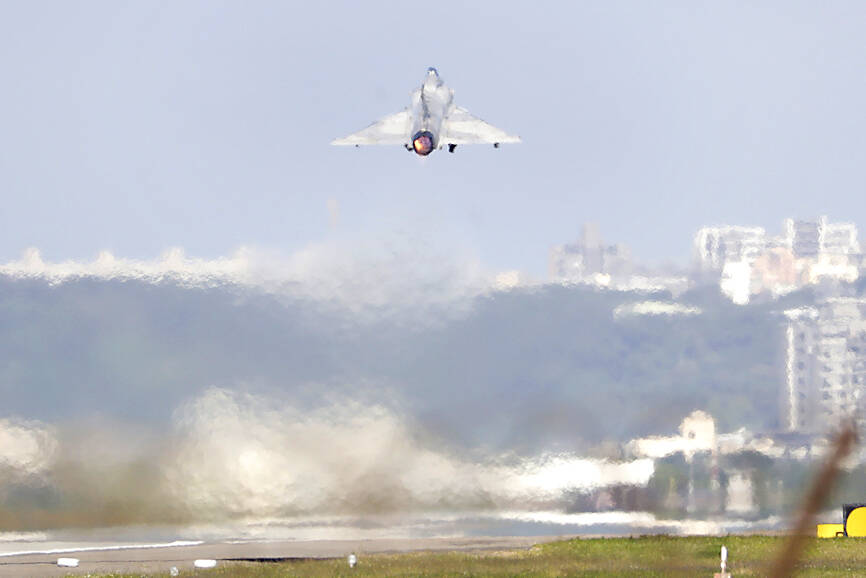
Photo: Chiang Ying-ying, AP
“We [the US] continue to call on the PRC [People’s Republic of China] to avoid any destabilizing or escalatory actions that might undermine regional peace and stability and will continue coordinating with allies and partners regarding our shared concerns,” the spokesperson said.
China from Monday to Wednesday designated seven areas east of Zhejiang Province and its Fujian Province as “temporary reserved” airspace, which typically indicates airspace reserved for military activities.
Foreign media reported that the PLA activity could mean another round of military exercises in response to Lai’s trip to the South Pacific from Nov. 30 to Friday last week, which included stopovers in Hawaii and the US territory of Guam.
The AIT said that although Beijing has not announced a “Joint Sword” military exercise in response to Lai’s transits, the elevated military activity in the region was consistent with levels the US has seen during other large exercises.
China’s latest military activity in the area followed the identification of 100 PLA aircraft operating around Taiwan in a 48-hour period starting at 6am on Monday.
The Ministry of National Defense earlier yesterday said that in the 24 hours to 6am, it had detected 34 Chinese military aircraft operating around the nation, down from 53 aircraft it reported the previous day.
However, there was a rise in PLA Navy ships in the area to 16 from 11 the prior day, the ministry said.
Twenty-two of the planes crossed the median line of the Taiwan Strait and flew into Taiwan’s northern, southwestern and eastern air defense identification zone, a ministry map showed.
Two officials familiar with the security situation in the region said that PLA Navy and China Coast Guard vessels are moving north, showing signs that the forces are being pulled back.
The defence ministry later on Thursday night said that an emergency response centre set up earlier this week to deal with recent Chinese military activities had been disbanded, likely signalling the end of to China’s manoeuvres around the island.
Separately, US Secretary of Defense Lloyd Austin on Wednesday told the DefenseScoop news Web site that the Pentagon is keeping a close eye on security conditions in and around Taiwan.
“Certainly, this latest activity is something that we will continue to monitor and make sure that nobody does anything to change the status quo in the [Taiwan Strait],” Austin told a news conference closing out a trip to Japan, the site reported.
“Our policy hasn’t changed. We’ll continue to do what we can to help Taiwan acquire the means to defend itself. Again, that work continues on. But this latest activity — we’ll continue to monitor it and see what happens,” he said.
Austin also expressed confidence that the U.S. military will continue to have the capacity and focus to deter China and work with its allies to promote peace around the Indo-Pacific, even as conflicts around the Middle East and in Ukraine continue to expand.
Additional reporting by Reuters
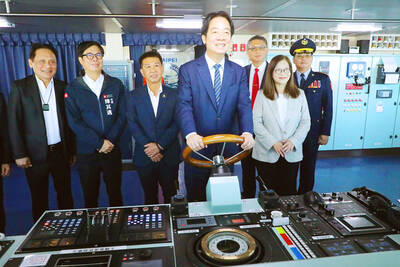
CALL FOR SUPPORT: President William Lai called on lawmakers across party lines to ensure the livelihood of Taiwanese and that national security is protected President William Lai (賴清德) yesterday called for bipartisan support for Taiwan’s investment in self-defense capabilities at the christening and launch of two coast guard vessels at CSBC Corp, Taiwan’s (台灣國際造船) shipyard in Kaohsiung. The Taipei (台北) is the fourth and final ship of the Chiayi-class offshore patrol vessels, and the Siraya (西拉雅) is the Coast Guard Administration’s (CGA) first-ever ocean patrol vessel, the government said. The Taipei is the fourth and final ship of the Chiayi-class offshore patrol vessels with a displacement of about 4,000 tonnes, Lai said. This ship class was ordered as a result of former president Tsai Ing-wen’s (蔡英文) 2018
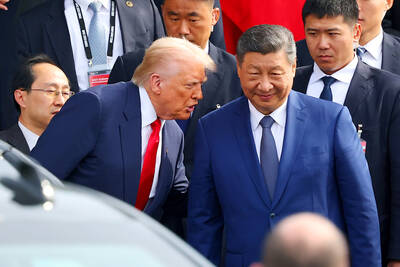
UKRAINE, NVIDIA: The US leader said the subject of Russia’s war had come up ‘very strongly,’ while Jenson Huang was hoping that the conversation was good Chinese President Xi Jinping (習近平) and US President Donald Trump had differing takes following their meeting in Busan, South Korea, yesterday. Xi said that the two sides should complete follow-up work as soon as possible to deliver tangible results that would provide “peace of mind” to China, the US and the rest of the world, while Trump hailed the “great success” of the talks. The two discussed trade, including a deal to reduce tariffs slapped on China for its role in the fentanyl trade, as well as cooperation in ending the war in Ukraine, among other issues, but they did not mention
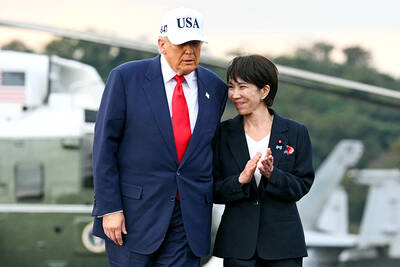
Japanese Prime Minister Sanae Takaichi yesterday lavished US President Donald Trump with praise and vows of a “golden age” of ties on his visit to Tokyo, before inking a deal with Washington aimed at securing critical minerals. Takaichi — Japan’s first female prime minister — pulled out all the stops for Trump in her opening test on the international stage and even announced that she would nominate him for a Nobel Peace Prize, the White House said. Trump has become increasingly focused on the Nobel since his return to power in January and claims to have ended several conflicts around the world,
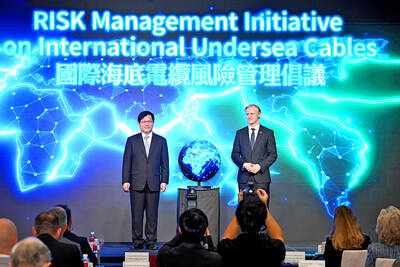
GLOBAL PROJECT: Underseas cables ‘are the nervous system of democratic connectivity,’ which is under stress, Member of the European Parliament Rihards Kols said The government yesterday launched an initiative to promote global cooperation on improved security of undersea cables, following reported disruptions of such cables near Taiwan and around the world. The Management Initiative on International Undersea Cables aims to “bring together stakeholders, align standards, promote best practices and turn shared concerns into beneficial cooperation,” Minister of Foreign Affairs Lin Chia-lung (林佳龍) said at a seminar in Taipei. The project would be known as “RISK,” an acronym for risk mitigation, information sharing, systemic reform and knowledge building, he said at the seminar, titled “Taiwan-Europe Subsea Cable Security Cooperation Forum.” Taiwan sits at a vital junction on